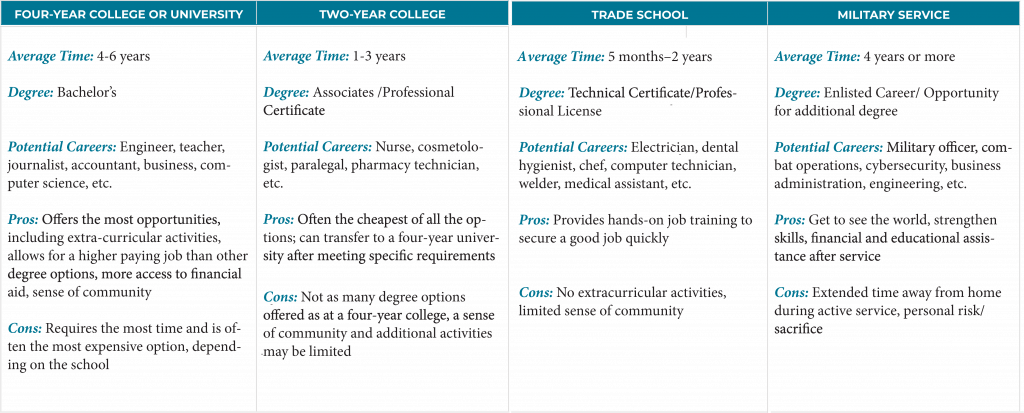The Importance of Early Learning
The learning process starts before students enter kindergarten, and it continues well after high school. While parental support throughout a child’s K-12 education is important, how a child is set up for school, and how they spend their time after graduation requires equal attention.
The brain grows 80-85% of its full adult size during the first 5 years of a child’s life. Children learn at a much faster rate during these first few years than at any other time in their lives. Stressful experiences during this time can slow a child’s brain growth and development. Sometimes these stressful situations are outside a parent’s control, but that doesn’t mean they can’t still provide a safe, supportive environment that promotes learning.
One way to promote a positive early learning environment is through meaningful interactions. Parents help their child’s brain development when they speak to their child and engage them in conversation even before children are walking and talking. Meaningful interactions between parents, children, and other individuals in a child’s life not only help their brains to develop but helps them feel supported by a network of caring adults.
Another way for parents to provide a supportive early learning environment is to enroll their child in a high-quality early education program. There are many different programs available for a child ages 0 to 5.
Research has shown that participation in high-quality early education programs help children:

Types of Early Education Programs
There are many early education options for parents depending on the age of their child, their income, and the overall needs of the family.
CHILD CARE
Child care programs enroll children from birth through Kindergarten, and up to age 12 for after-school programs. Availability for each age group at a location will be different based on their size and wait-lists. Child care can be offered at a center or in a home. All centers and homes must follow minimum expectations set by the state, but these do not indicate whether the program is quality.
Child care can be paid for by the parent or can be subsidized, meaning the government pays for care. With subsidized child care, parents receive financial aid to help pay for childcare if they work or attend an education or vocational training program for at least 25 hours per week and if they meet certain income guidelines.
Private pay child care is offered through licensed child care centers, local community centers like the YMCA, and faith-based locations such as a church. The fees and program rules vary by location. Families can search for licensed child care centers in their area by visiting the Texas Health and Human Services website dfps.state.tx.us and using their
“Find Child Care” search.
EARLY HEAD START & HEAD START
Early Head Start (for children 0-3) and Head Start (for 4-year-old children) are free programs that offer a variety of services for pregnant women and children from birth to age 5, such as education, health, nutrition, and social services. Early Head Start and Head Start programs are regulated by the U.S government and are required to meet certain national standards. Families can qualify through income levels, homelessness, having children in foster care, or if they are receiving funds from Supplemental Security Income (SSI) or Temporary Assistance for Needy Families (TANF).
To find an Early Head Start or Head Start location, call 1-866-763-6481 or visit eclkc.ohs.acf.hhs.gov/center-locator. To qualify parents must meet income requirements. Visit benefits.gov/benefits/benefit-details/1941 to learn more about Head Start.
HOME VISITING PROGRAMS
Texas provides free home visiting services for many expectant parents and parents with children six years old and younger. Home visiting programs match parents with someone who can answer their questions, recommend services, and give advice. Depending on a parent’s needs this “home visitor” may be a nurse, an experienced parent, or another trained professional. Among other resources, home visitors provide parents with tools to keep their children happy, healthy, and ready for school. There are different home visiting programs available to Texas parents, and each has its own eligibility requirements.

For more information about home visiting visit texashomevisiting.org
PRE-KINDERGARTEN (PRE-K)
Public Pre-K is offered by school districts for children who turn 4 years old on or before September 1st of the upcoming school year. While Pre-K participation is not required by the state, there are many academic and social benefits. While most Pre-K programs prioritize four-year-olds, many districts offer services for 3-year-olds as well, depending on available space and resources. Half-day and full-day programs are available.
Public Pre-K is provided for free for children who meet at least one of the following:
• Qualify for free or reduced-price lunch
• Are homeless
• Have limited English proficiency
• Are in foster care
• Have a parent in the military
• Have had a parent die in the line of duty (police officer, firefighter, etc).
For children who do not meet one of the five criteria above, districts may offer a limited number of Pre-K spots for a fee. Private Pre-K is also available. These programs usually require students to pay tuition and complete an application process that may include tests, interviews, and financial aid forms.
KINDERGARTEN
Full-day kindergarten is available for free to all children who turn 5 by September 1st of that school year and is offered on the campus of local elementary schools.
Choosing Quality Early Ed
 Attending a high-quality early education program makes a big difference for young children, but not every early education program can be considered “high-quality.” Just as with K-12 schools, parents should consider the environment and culture when selecting an early education program. Characteristics such as the number of children per teacher in a classroom, staff friendliness, cleanliness, and safety can vary at each program, even if they are certified by the state. While cost, availability, and location may still drive which programs parents choose for their child, program quality should factor into their decisions whenever possible.
Attending a high-quality early education program makes a big difference for young children, but not every early education program can be considered “high-quality.” Just as with K-12 schools, parents should consider the environment and culture when selecting an early education program. Characteristics such as the number of children per teacher in a classroom, staff friendliness, cleanliness, and safety can vary at each program, even if they are certified by the state. While cost, availability, and location may still drive which programs parents choose for their child, program quality should factor into their decisions whenever possible.
Parents can learn more about the quality of their local early education programs by visiting in person, speaking with other parents and friends, and looking at a provider’s quality rating or accreditation. Texas Rising Star (TRS) for example, rates subsidized child care providers based on their quality.TRS certified child care centers and homes go beyond Texas’ minimum standards and can receive up to 4 stars.
To find TRS providers in your area visit texasrisingstar.org/parent/find-a-trs-provider
Developmental Screening
With so much learning and development happening before children even enter school, parents may worry their child might not be developing fast enough or be on track for kindergarten. Children are more likely to be successful in school when they enter kindergarten with a strong foundation of knowledge and skills. Kindergarten readiness is typically measured across 5 areas of development including:
If a parent is concerned, free developmental screening tools are available online to parents, to help them identify how their child is progressing and flag issues early on. Visit earlyisbestnorthtexas.org/screening/ to learn how to access the free screening tool.
Setting a College & Career Ready Mindset
It is never too early for students and their parents to start thinking about life after high school. Setting expectations high and from an early age can positively impact student performance, attitudes, and aspirations for life after graduation. On average, students who continue their education after high school are less likely to suffer from unemployment and can earn more money over the course of their lifetime. While college may not be the best choice for everyone, every student has the potential to go to college and should have the option.
Starting as early as middle school, students begin the coursework necessary for college. The classes and performance required to graduate high school and to be eligible for college acceptance are not the same. Parents should be aware of these differences and help guide their student through the process. Before their child enters 8th grade, parents should review their child’s choices and available endorsements under Texas’ Foundation High School Program.
Visit texasoncourse.org for more information on college requirements and resources to help families plan for life after high school.
COLLEGE-ELIGIBLE VS. COLLEGE READY
Just because a student is accepted to college, doesn’t mean they will be successful. Parents can push their child to go above the minimum eligibility requirements and help them develop the skills needed to complete their college degrees successfully.
 College-Eligible students will have completed the required coursework, taken the SAT or ACT exam, have at least a 2.0 GPA or higher, and be on track to earn their high school diploma. These students are likely to be accepted to some programs, but may require remedial coursework or may have difficulty adapting to the work and expectations.
College-Eligible students will have completed the required coursework, taken the SAT or ACT exam, have at least a 2.0 GPA or higher, and be on track to earn their high school diploma. These students are likely to be accepted to some programs, but may require remedial coursework or may have difficulty adapting to the work and expectations.
 College-Ready students will have completed advanced coursework (Honors, AP, IB, etc.), will have a 3.0 GPA or higher, will score at least 1110 on the SAT or 24 ACT, and will have a history of participation in school clubs, activities, leadership, volunteer work, jobs, or internships. These students will also be accepted into a program, but are more likely to succeed in the program and graduate on time.
College-Ready students will have completed advanced coursework (Honors, AP, IB, etc.), will have a 3.0 GPA or higher, will score at least 1110 on the SAT or 24 ACT, and will have a history of participation in school clubs, activities, leadership, volunteer work, jobs, or internships. These students will also be accepted into a program, but are more likely to succeed in the program and graduate on time.
COLLEGE-READY STUDENTS ARE RESPONSIBLE, ORGANIZED, DETERMINED, FLEXIBLE, RESILIENT, CRITICAL THINKERS, & PROBLEM SOLVERS.
COLLEGE-READY TIMELINE
Start preparing students for college and career as early as possible. Together, parents can help students make their college-going dreams become a reality!

Higher Education Opportunities
Students have many options for continuing their education after high school. These options may include a four-year college or university, a two-year college (often known as a community college or junior college), a trade school, or the US military, among others. Every post-high school opportunity has its own long-term benefits, potential challenges and admission requirements.

CHOOSING A HIGHER EDUCATION PROGRAM
When choosing a college, university or different higher education path, there are many factors for students and families to consider. Affordability, location, available programs or majors, school reputation, quality of career services, etc.; a great deal goes into finding the right fit. Consider the following steps when it comes time to choose the best program:
1. Create a list of potential schools:
Before a student’s junior year of high school, develop a list together of potential colleges and universities they would like to learn more about and possibly apply to in the fall of their senior year. Be sure to include safety schools, match schools, and reach schools.
 Safety Schools – Student’s school grades and test scores are above the school’s average for incoming freshman, and there is a high likelihood he or she will be accepted.
Safety Schools – Student’s school grades and test scores are above the school’s average for incoming freshman, and there is a high likelihood he or she will be accepted.
 Match Schools – Student’s school grades and test scores are within the range of the school’s average incoming freshman.
Match Schools – Student’s school grades and test scores are within the range of the school’s average incoming freshman.
 Reach Schools – Student’s school grades and test scores may be below the school’s average incoming freshman, and your child may or may not be accepted, but there is still potential.
Reach Schools – Student’s school grades and test scores may be below the school’s average incoming freshman, and your child may or may not be accepted, but there is still potential.
2. Visit schools:
Before spending money on applications, try to visit schools when possible. Visiting the campus can be extremely helpful and can provide a better understanding of the school’s environment and culture.
For families unable to visit schools in person, a few online resources can help:
• Video tours of colleges: youniversitytv.com/category/college
• College Scorecard: collegescorecard.ed.gov
3. Apply to schools:
Submissions of online applications, standardized test scores, high school grades, essays, and information about activities outside of school are common, and some schools charge application fees. Most applications are due in the fall of a child’s senior year. Check college websites early and add application deadlines to family calendars to make sure everything gets in on time. Students apply for admission to any Texas public university, as well as some community and private colleges, at applytexas.org. To apply for schools in other states, check out commonapp.org or visit the school’s specific website.
4. Consider options and make a decision:
Once letters of acceptance and financial aid packages come in, there are a few important factors for students to consider.




 Federal Student Aid
Federal Student Aid Texas Financial Aid:
Texas Financial Aid: Scholarships:
Scholarships: